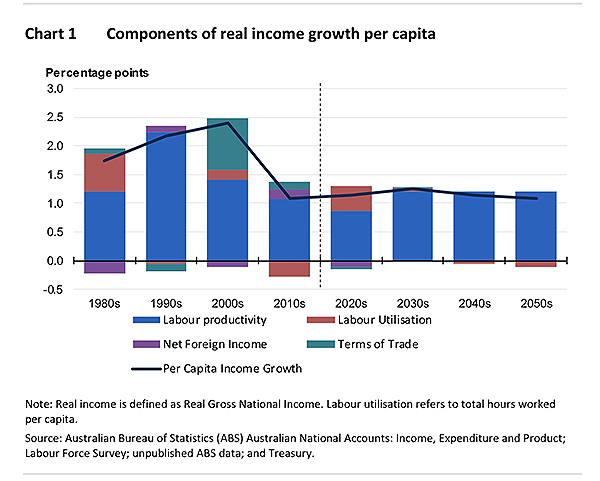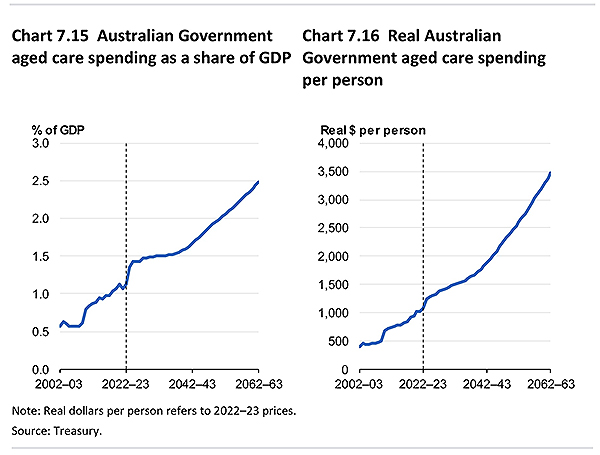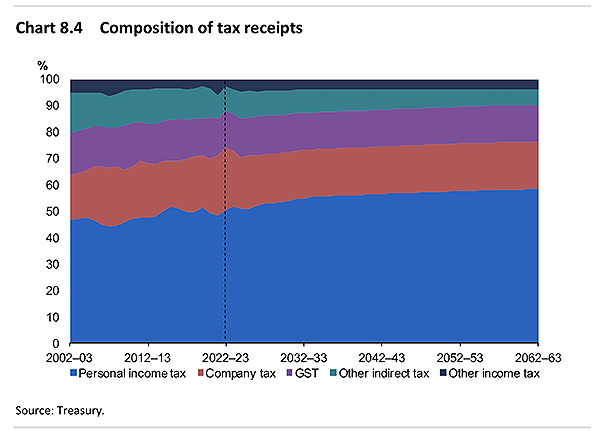
It’s very easy to get caught up in the short termism of modern politics. Too often the focus of political parties only extends as far as the next election.
In that context, Australia’s Intergenerational Report 2023 is something of an outlier. In the words of the Australian Treasurer, Jim Chalmers, the Report ‘provides a big picture view of the forces that will shape our economy and fiscal position over the next 40 years’.
Obviously, there are major difficulties in 40-year forecasting. Who knows what pandemics, wars, climate disasters, and financial crises will occur between now and 2063. Nevertheless, the exercise is a useful one and the latest iteration (the sixth since 2002) reveals some significant trends and challenges for Australia.
Many of them are equally relevant to New Zealand.
Unsurprisingly, demographics underlies much of the analysis in the Report. The projected ageing of Australia’s population will have a dramatic impact on economic growth and the government’s budget.
The Report predicts average annual economic growth of 2.2% over the next 40 years, compared to 3.1% over the previous 40 years. This reflects decline or slower growth over that period in the three key drivers of economic growth – working-age population, participation in the workforce, and labour productivity.
The median age in Australia is projected to rise by 4.6 years to 43.1. Crucially, the proportion aged between 15 and 64 will fall by 3.5 percentage points to 61.2%, and the proportion aged over 65 will increase by 6.1 percentage points to 23.4%. This heralds a big change in the ratio of workers to retirees.
It’s also expected that both the workforce participation rate and the average hours worked will decline.
Significantly, these developments will reduce the per capita productive capacity of the Australian economy.
The position would be much worse without Australia’s relatively high level of immigration. The Report recognises the need to continue targeted immigration in the years ahead.
It also highlights the centrality of productivity to future economic growth. Chart 1 in the Report says it all.

The chart shows that productivity growth has been the outstanding driver of per capita income growth in Australia for the last 40 years and will be for the next 40.
As economist Paul Krugman put it, ‘Productivity isn’t everything, but in the long run, it’s almost everything’.
The Report states that ‘continuing to improve productivity will be important to realising future economic opportunities and ensuring continued strong growth in living standards’. It assumes productivity growth of 1.2% per annum until 2063 but notes that’s not ‘a foregone conclusion’ and will be dictated by many factors including the decisions of governments and businesses, and global economic forces.
It’s not just economic growth that’s negatively affected by the ageing population. So too is the expenditure side of the nation’s budget.
The Report forecasts that over the next 40 years total government spending will increase by 3.8 percentage points of GDP. It attributes 40% of that increase to the ageing population. The major contributors will be aged care and health.
The charts below from the Report record the unrelenting rise in the cost of aged care. If the predictions are correct, as a percentage of GDP the cost will have gone up by a factor of five from 2003 to 2063. And by a factor of seven in dollar terms.

Such a massive increase in aged care costs while the proportion of Australians in the workforce declines raises an obvious question – where will the aged care workers come from to provide all the extra aged care services required? Immigration is part of the answer. AI may be another.
There is one saving grace in the Report. The budget will not experience a large rise in the cost of the age pension. In fact, thanks to Australia’s compulsory superannuation system and a means tested age pension, that cost as a percentage of GDP will actually fall over the next 40 years.
Perhaps the most controversial trend revealed in the Report is the forecast lift in the budget’s reliance on personal income tax.
Indirect taxes are projected to fall markedly. Tobacco excise will drop with smoking rates and petrol excise will drop with the rise of electric vehicles.
GST will remain broadly flat as a percentage of GDP. (The lack of any increase is partly a result of the limited scope of Australia’s GST. NZ would do well to stick with its comprehensive coverage and higher rate.)
Company taxes are expected to fall due to a drop in commodity prices from their current elevated levels and then to flatline. Furthermore, at 30%, Australia’s corporate tax rate is arguably too high to be internationally competitive and needs to come down. That would reduce the company tax take even further.
According to the Report, the shortfall from declining indirect and company taxes will be made up by a rise in the personal income tax take. The latter will climb from 11.7% of GDP currently to 14.3% by 2063. As a percentage of total tax revenue, it will climb from 50% to nearly 60%.

This trend is particularly problematic given the relative decline in the working age population. Proportionally fewer workers will have to contribute an increasing share of government revenue.
As if climate change, student debt, unaffordable housing, and paying off the Covid debt weren’t enough, today’s young people will be expected to pay exorbitant personal tax to fund the rising costs of looking after an ever-growing number of elderly Australians.
Former Treasury Secretary Ken Henry has labeled it an ‘intergenerational tragedy’.
The reality is, it’s unsustainable. The current Treasurer realises something must be done but the dynamics of electoral politics mean that, from his perspective, now is not a good time. But it never is.
According to the Treasury website, the Report ‘will help inform and improve public policy settings to better position Australia for the next 40 years’.
The government needs to get on with it.
*Ross Stitt is a freelance writer with a PhD in political science. He is a New Zealander based in Sydney. His articles are part of our 'Understanding Australia' series.
11 Comments
It is not the next four decades but it maybe the last four years. Population slightly shrinking but being replaced by enthusiastic foreigners desperate to assimilate (just look at many UK conservative party ministers). The tide of western culture went out years ago.
No comments thus far, on the obvious failure, both of the report and of the journalism.
https://sustainable.unimelb.edu.au/__data/assets/pdf_file/0005/2763500/…
Note that paper comes from the same country. Ignorance is an amazing avoidance-tool. Note the graphs, P8, P11, and on. Read it and weep.
Have to say these reports (NZ does similar projections) seem to ignore the fact that migration currently sustains us and is likely to keep doing so unless we become more despotic than other partially educated populations. We lose our best and brightest while inheriting them from the next tier countries - unless that stops then neither AU or NZ will struggle for growth - it just won’t be the kind we’re so keen on.
Why use the word 'migration' without qualifying adjectives? The people arriving in NZ include some of the very brightest and most hard working from their country of origin. On the other hand it is easy to bring in the dregs too. The desperate unable to get into more selective countries.
Having a professional trade unionist as minister of immigration is significant - only two months into the job and already the naive exploited desperate 3rd world immigrants are being identified and the evil rogues who cheated them are likely to be prosecuted.
If we bleed every other country of their best and brightest, don't we just end up in a death loop having to support these countries through various aid programs due to ours and others stripping them of their needed citizens. Some kind of world population control is needed, not that it will ever happen, agreement and compliance would be required.

We welcome your comments below. If you are not already registered, please register to comment.
Remember we welcome robust, respectful and insightful debate. We don't welcome abusive or defamatory comments and will de-register those repeatedly making such comments. Our current comment policy is here.